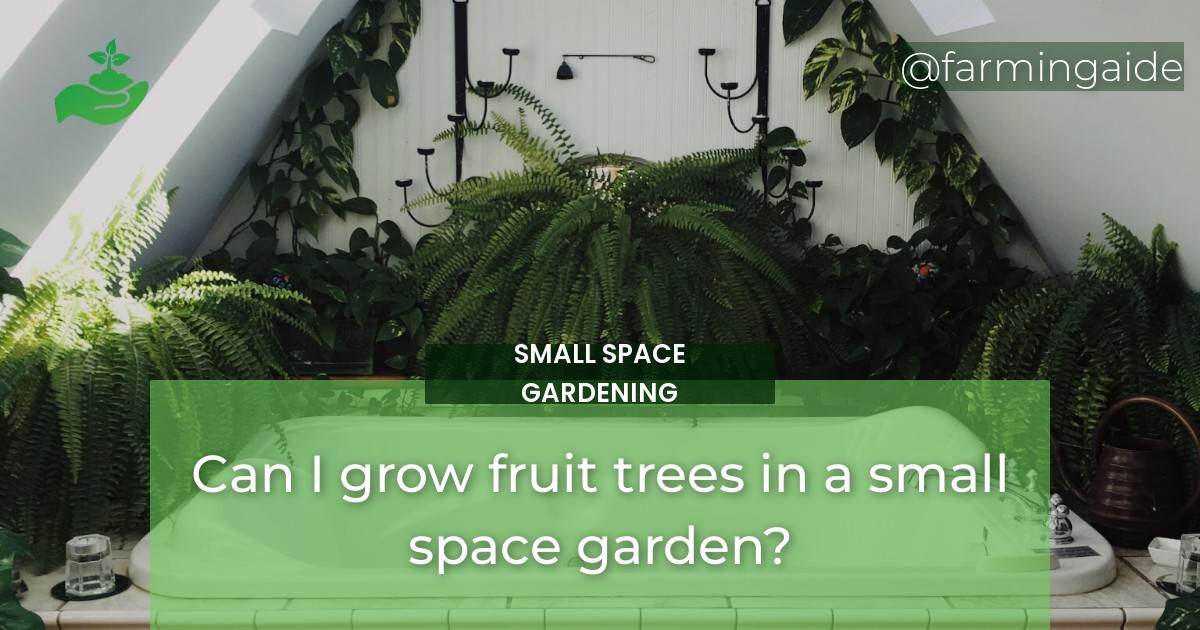Growing fruit trees in small spaces is definitely possible! With urban fruit gardening on the rise, more and more people are turning to small space fruit gardens to enjoy fresh, homegrown produce. However, it’s important to choose the right fruit trees, containers, soil, and fertilizers, and to prune and train the trees properly to ensure a bountiful harvest. In this article, we’ll explore the best fruit trees for small space gardening, how to choose the right container, the best soil and fertilizers for fruit trees, pruning and training techniques, common pests and diseases, and proper harvesting and storage techniques.
Best Fruit Trees for Small Space Gardening
Dwarf Fruit Trees
Dwarf fruit trees are the perfect solution for small space fruit gardens. They are small in size, typically reaching a height of 6 to 8 feet, and can easily be grown in containers. Dwarf fruit trees are available in a variety of fruit types, including apple, peach, cherry, and plum. Some popular dwarf fruit tree varieties include:
- ‘Stella’ cherry tree
- ‘Honeycrisp’ apple tree
- ‘Contender’ peach tree
- ‘Ruby Sweet’ plum tree
Columnar Fruit Trees
Columnar fruit trees are another great option for small space fruit gardens. These trees are tall and narrow, with a height of up to 10 feet and a width of only 2 to 3 feet. They are perfect for growing in containers, and can be planted closer together than traditional fruit trees. Some popular columnar fruit tree varieties include:
- ‘Scarlet Sentinel’ apple tree
- ‘Northpole’ columnar apple tree
- ‘Golden Sentinel’ apple tree
- ‘Starkspur Ultra Columnar’ peach tree
Espalier Fruit Trees
Espalier fruit trees are a unique and beautiful way to grow fruit in small spaces. These trees are trained to grow flat against a wall or trellis, taking up very little space. They require regular pruning and training to maintain their shape, but can be very productive. Some popular espalier fruit tree varieties include:
- ‘Liberty’ espalier apple tree
- ‘Fan-Trained’ espalier pear tree
- ‘Espalier’ peach tree
- ‘Espalier’ cherry tree
Choosing the Right Container
Size of Container
When choosing a container for your fruit tree, it’s important to choose one that is the right size. The container should be large enough to accommodate the roots of the tree, but not so large that it takes up too much space. A good rule of thumb is to choose a container that is at least twice the size of the root ball of the tree.
Material of Container
The material of the container is also important. Clay and ceramic containers are popular choices, as they are porous and allow for good drainage. Plastic containers are also a good choice, as they are lightweight and easy to move. Avoid metal containers, as they can get too hot in the sun and damage the roots of the tree.
Drainage
Proper drainage is essential for the health of your fruit tree. Make sure your container has drainage holes in the bottom to allow excess water to escape. You can also add a layer of gravel or stones to the bottom of the container to improve drainage.
ALSO READ
Soil and Fertilizers
Choosing the Right Soil
The soil you choose for your fruit tree is important for its growth and productivity. Choose a high-quality potting soil that is well-draining and rich in organic matter. You can also add perlite or vermiculite to improve drainage.
Fertilizers for Fruit Trees
Fruit trees require regular fertilization to produce a good crop. Use a slow-release fertilizer specifically formulated for fruit trees, following the instructions on the package. You can also add compost or a balanced fertilizer in the spring and fall to provide additional nutrients.
Pruning and Training Fruit Trees
Pruning Techniques
Pruning is essential for the health and productivity of your fruit tree. Prune your tree in the late winter or early spring, before new growth appears. Remove any dead or diseased branches, as well as any branches that are crossing or rubbing against each other. Also remove any water sprouts or suckers that are growing from the base of the tree.
Training Techniques
Training your fruit tree is important for its shape and productivity. Depending on the variety of tree you have, you may want to train it to a single trunk or multiple trunks. You can also use stakes or trellises to support the branches and encourage upward growth.
ALSO READ
Pests and Diseases
Common Pests
Fruit trees are susceptible to a variety of pests, including aphids, scale insects, and spider mites. Regularly inspect your tree for signs of infestation, and spray with a pest control solution if necessary.
Common Diseases
Fruit trees are also susceptible to diseases such as powdery mildew and apple scab. Proper pruning and training can help prevent these diseases, as can regular applications of fungicide.
Prevention and Treatment
The best way to prevent pests and diseases is to keep your fruit tree healthy and strong. Provide proper care and maintenance, and promptly treat any infestations or diseases that do occur.
Harvesting and Storage
When to Harvest
The timing of your harvest will depend on the variety of fruit tree you have. In general, fruit should be harvested when it is fully ripe and has a good flavor. Use a fruit picker to gently remove the fruit from the tree.
Proper Storage Techniques
Fruit should be stored in a cool, dry place to prevent spoilage. Depending on the type of fruit, it may also need to be refrigerated or frozen. Use airtight containers or freezer bags to store your fruit, and label them with the date of harvest.
Conclusion
Growing fruit in small areas is definitely possible with the right fruit trees, containers, soil, fertilizers, pruning and training techniques, and pest and disease prevention and treatment. By following these tips, you can enjoy fresh, homegrown fruit from your small space fruit garden!


